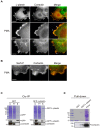Quantitative kinetic study of the actin-bundling protein L-plastin and of its impact on actin turn-over
- PMID: 20169155
- PMCID: PMC2821400
- DOI: 10.1371/journal.pone.0009210
Quantitative kinetic study of the actin-bundling protein L-plastin and of its impact on actin turn-over
Abstract
Background: Initially detected in leukocytes and cancer cells derived from solid tissues, L-plastin/fimbrin belongs to a large family of actin crosslinkers and is considered as a marker for many cancers. Phosphorylation of L-plastin on residue Ser5 increases its F-actin binding activity and is required for L-plastin-mediated cell invasion.
Methodology/principal findings: To study the kinetics of L-plastin and the impact of L-plastin Ser5 phosphorylation on L-plastin dynamics and actin turn-over in live cells, simian Vero cells were transfected with GFP-coupled WT-L-plastin, Ser5 substitution variants (S5/A, S5/E) or actin and analyzed by fluorescence recovery after photobleaching (FRAP). FRAP data were explored by mathematical modeling to estimate steady-state reaction parameters. We demonstrate that in Vero cell focal adhesions L-plastin undergoes rapid cycles of association/dissociation following a two-binding-state model. Phosphorylation of L-plastin increased its association rates by two-fold, whereas dissociation rates were unaffected. Importantly, L-plastin affected actin turn-over by decreasing the actin dissociation rate by four-fold, increasing thereby the amount of F-actin in the focal adhesions, all these effects being promoted by Ser5 phosphorylation. In MCF-7 breast carcinoma cells, phorbol 12-myristate 13-acetate (PMA) treatment induced L-plastin translocation to de novo actin polymerization sites in ruffling membranes and spike-like structures and highly increased its Ser5 phosphorylation. Both inhibition studies and siRNA knock-down of PKC isozymes pointed to the involvement of the novel PKC-delta isozyme in the PMA-elicited signaling pathway leading to L-plastin Ser5 phosphorylation. Furthermore, the L-plastin contribution to actin dynamics regulation was substantiated by its association with a protein complex comprising cortactin, which is known to be involved in this process.
Conclusions/significance: Altogether these findings quantitatively demonstrate for the first time that L-plastin contributes to the fine-tuning of actin turn-over, an activity which is regulated by Ser5 phosphorylation promoting its high affinity binding to the cytoskeleton. In carcinoma cells, PKC-delta signaling pathways appear to link L-plastin phosphorylation to actin polymerization and invasion.
Conflict of interest statement
Figures





References
-
- Fidler IJ. Critical determinants of cancer metastasis: rationale for therapy. Cancer Chemother Pharmacol. 1999;43(Suppl):S3–10. - PubMed
-
- Matsushima K, Shiroo M, Kung HF, Copeland TD. Purification and characterization of a cytosolic 65-kilodalton phosphoprotein in human leukocytes whose phosphorylation is augmented by stimulation with interleukin 1. Biochemistry. 1988;27:3765–3770. - PubMed
-
- Lapillonne A, Coue O, Friederich E, Nicolas A, Del Maestro L, et al. Expression patterns of L-plastin isoform in normal and carcinomatous breast tissues. Anticancer Res. 2000;20:3177–3182. - PubMed
-
- Park T, Chen ZP, Leavitt J. Activation of the leukocyte plastin gene occurs in most human cancer cells. Cancer Res. 1994;54:1775–1781. - PubMed
-
- Lin CS, Park T, Chen ZP, Leavitt J. Human plastin genes. Comparative gene structure, chromosome location, and differential expression in normal and neoplastic cells. J Biol Chem. 1993;268:2781–2792. - PubMed
Publication types
MeSH terms
Substances
LinkOut - more resources
Full Text Sources
Other Literature Sources
Molecular Biology Databases
Miscellaneous

